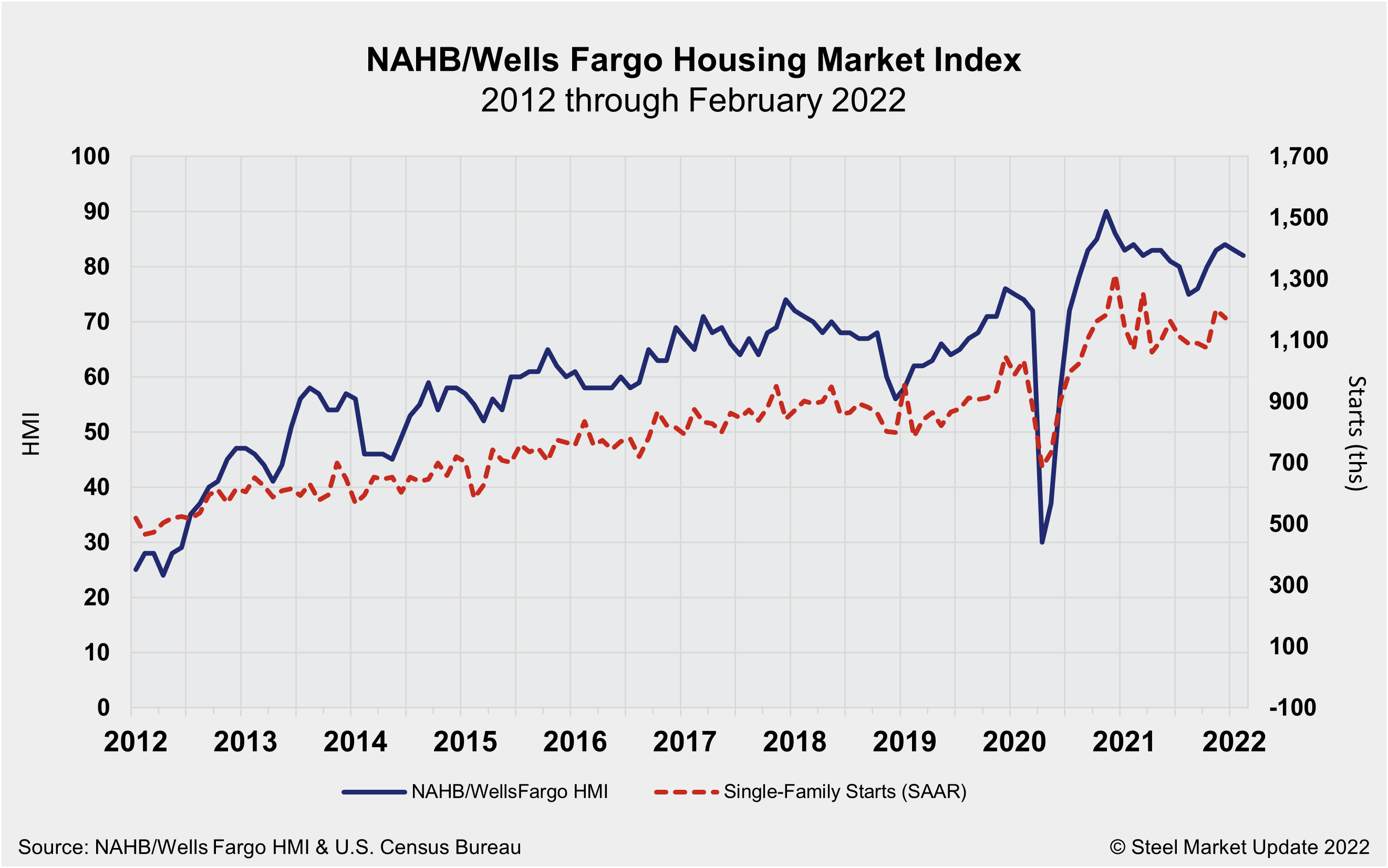Steel Markets

NAHB: Builder Confidence Slips Further in February
Written by David Schollaert
February 20, 2022
Builder confidence fell again in February despite strong demand from buyers, according to the National Association of Home Builders/Wells Fargo Housing Market Index (HMI).
Home builder sentiment fell for the second straight month on ongoing building material production bottlenecks, which have pushed up construction costs and delayed projects.
February’s HMI reading moved one point lower to a reading of 82. Despite two months of declines, the HMI has posted solid readings at or above the 80-point mark for the past five months.
“Production disruptions are so severe that many builders are waiting months to receive cabinets, garage doors, countertops and appliances,” NAHB Chairman Jerry Konter said. “These delivery delays are raising construction costs and pricing prospective buyers out of the market. Policymakers must make it a priority to address supply chain issues that are harming housing affordability.”

The NAHB/Wells Fargo HMI survey gauges builder perceptions of current single-family home sales and sales expectations for the next six months as “good,” “fair” or “poor.” The survey also asks builders to rate traffic of prospective buyers as “high to very high,” “average” or “low to very low.” Scores for each component are then used to calculate a seasonally adjusted index where any number over 50 indicates that more builders view conditions as good than poor.
Two out of the three major HMI indices posted decreases in February. The gauge charting traffic of prospective buyers posted a four-point decline to 65 while the component measuring sales expectations in the next six months fell two points to 80. The index gauging current sales conditions rose one point at a reading of 90.
“Residential construction costs are up 21% on a year-over-year basis, and these higher development costs have hit first-time buyers particularly hard,” said Robert Dietz, NAHB’s chief economist. “Higher interest rates in 2022 will further reduce housing affordability even as demand remains solid due to a lack of resale inventory.”
Looking at the three-month moving averages for regional HMI scores, the Northeast increased three points to 76, the West increased one point to 89, and the South and Midwest each posted a one-point decrease to 86 and 73, respectively.
By David Schollaert, David@SteelMarketUpdate.com

David Schollaert
Read more from David SchollaertLatest in Steel Markets

CMC looks beyond Arizona micro-mill woes to long-term viability of construction mart
Despite the economic and geopolitical upheaval of the last five years, CMC President and CEO Peter Matt points out that the construction market has been an essential element of the way forward.

US importers face stricter rules under revamped S232 tariffs
“CBP expects full compliance from the trade community for accurate reporting and payment of the additional duties. CBP will take enforcement action on non-compliance," the agency said in a March 7 bulletin.

Steel exports rebound in January
US steel exports recovered to a five-month high in January after having fallen to a two-year low in December. This growth follows four consecutive months of declining exports.

Construction spending drops marginally in January
Construction spending edged down slightly in January, slipping for the first time in four months. The US Census Bureau estimated spending at a seasonally adjusted annual rate of $2,196 billion in January, down 0.2% from December’s downward revised rate. The January figure is 3.3% higher than a year ago. January’s result, despite the slight erosion, […]

HVAC equipment shipments slow in December but strong annually
Shipments of heating and cooling equipment in the US fell to an 11-month low in December, according to the latest data released by the Air-Conditioning, Heating, and Refrigeration Institute (AHRI).
